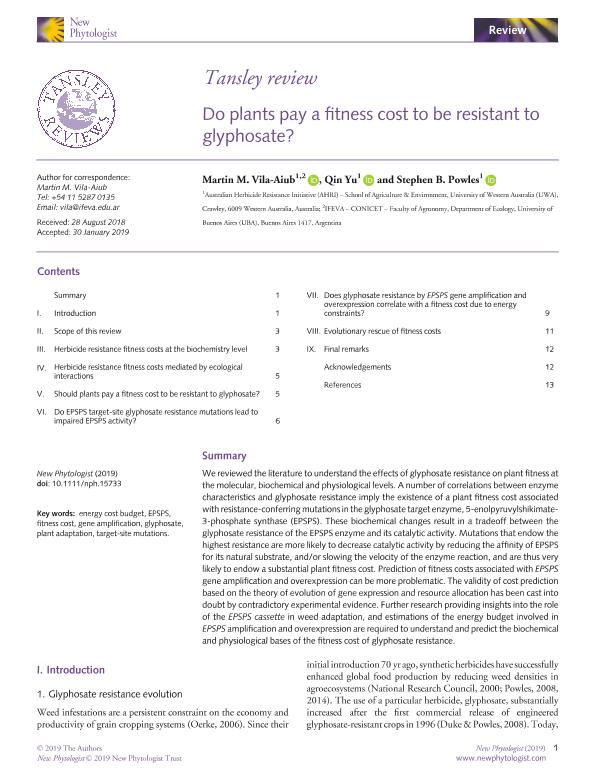Mostrar el registro sencillo del ítem
dc.contributor.author
Vila Aiub, Martin Miguel

dc.contributor.author
Yu, Qin
dc.contributor.author
Powles, Stephen B.

dc.date.available
2021-09-10T22:38:06Z
dc.date.issued
2019-02-08
dc.identifier.citation
Vila Aiub, Martin Miguel; Yu, Qin; Powles, Stephen B.; Do plants pay a fitness cost to be resistant to glyphosate?; Wiley Blackwell Publishing, Inc; New Phytologist; 223; 2; 8-2-2019; 532-547
dc.identifier.issn
0028-646X
dc.identifier.uri
http://hdl.handle.net/11336/140156
dc.description.abstract
We reviewed the literature to understand the effects of glyphosate resistance on plant fitness at the molecular, biochemical and physiological levels. A number of correlations between enzyme characteristics and glyphosate resistance imply the existence of a plant fitness cost associated with resistance-conferring mutations in the glyphosate target enzyme, 5-enolpyruvylshikimate-3-phosphate synthase (EPSPS). These biochemical changes result in a tradeoff between the glyphosate resistance of the EPSPS enzyme and its catalytic activity. Mutations that endow the highest resistance are more likely to decrease catalytic activity by reducing the affinity of EPSPS for its natural substrate, and/or slowing the velocity of the enzyme reaction, and are thus very likely to endow a substantial plant fitness cost. Prediction of fitness costs associated with EPSPS gene amplification and overexpression can be more problematic. The validity of cost prediction based on the theory of evolution of gene expression and resource allocation has been cast into doubt by contradictory experimental evidence. Further research providing insights into the role of the EPSPS cassette in weed adaptation, and estimations of the energy budget involved in EPSPS amplification and overexpression are required to understand and predict the biochemical and physiological bases of the fitness cost of glyphosate resistance.
dc.format
application/pdf
dc.language.iso
eng
dc.publisher
Wiley Blackwell Publishing, Inc

dc.rights
info:eu-repo/semantics/openAccess
dc.rights.uri
https://creativecommons.org/licenses/by-nc-sa/2.5/ar/
dc.subject
ENERGY COST BUDGET
dc.subject
EPSPS
dc.subject
FITNESS COST
dc.subject
GENE AMPLIFICATION
dc.subject
GLYPHOSATE
dc.subject
PLANT ADAPTATION
dc.subject
TARGET-SITE MUTATIONS
dc.subject.classification
Agronomía, reproducción y protección de plantas

dc.subject.classification
Agricultura, Silvicultura y Pesca

dc.subject.classification
CIENCIAS AGRÍCOLAS

dc.title
Do plants pay a fitness cost to be resistant to glyphosate?
dc.type
info:eu-repo/semantics/article
dc.type
info:ar-repo/semantics/artículo
dc.type
info:eu-repo/semantics/publishedVersion
dc.date.updated
2020-12-15T14:17:38Z
dc.journal.volume
223
dc.journal.number
2
dc.journal.pagination
532-547
dc.journal.pais
Reino Unido

dc.description.fil
Fil: Vila Aiub, Martin Miguel. University of Western Australia; Australia. Consejo Nacional de Investigaciones Científicas y Técnicas. Oficina de Coordinación Administrativa Parque Centenario. Instituto de Investigaciones Fisiológicas y Ecológicas Vinculadas a la Agricultura. Universidad de Buenos Aires. Facultad de Agronomía. Instituto de Investigaciones Fisiológicas y Ecológicas Vinculadas a la Agricultura; Argentina
dc.description.fil
Fil: Yu, Qin. University of Western Australia; Australia
dc.description.fil
Fil: Powles, Stephen B.. University of Western Australia; Australia
dc.journal.title
New Phytologist

dc.relation.alternativeid
info:eu-repo/semantics/altIdentifier/doi/http://dx.doi.org/10.1111/nph.15733
dc.relation.alternativeid
info:eu-repo/semantics/altIdentifier/url/https://nph.onlinelibrary.wiley.com/doi/10.1111/nph.15733
Archivos asociados
